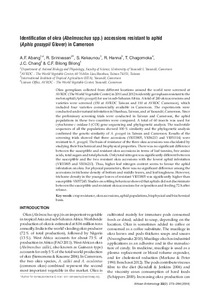| dc.contributor.author | Abang, A.F. |
| dc.contributor.author | Srinivasan, R. |
| dc.contributor.author | Kekeunou, S. |
| dc.contributor.author | Hanna, R. |
| dc.contributor.author | Chagomoka, Takemore |
| dc.contributor.author | Chang, J.C. |
| dc.contributor.author | Bilong-Bilong, C.F. |
| dc.date.accessioned | 2019-12-04T11:03:24Z |
| dc.date.available | 2019-12-04T11:03:24Z |
| dc.date.issued | 2014 |
| dc.identifier.citation | Abang, A.F., Srinivasan, R., Kekeunou, S., Hanna, R., Chagomoka, T., Chang, J.C. & Bilong-Bilong, C.F. (2014). Identification of okra (Abelmoschus spp.) accessions resistant to aphid (Aphis gossypii Glover) in Cameroon. African Entomology, 22(2), 273-284. |
| dc.identifier.issn | 1021-3589 |
| dc.identifier.uri | https://hdl.handle.net/20.500.12478/1039 |
| dc.description.abstract | Okra germplasm collected from different locations around the world were screened atAVRDC(TheWorldVegetable Center) in 2011 and 2012 to identify germplasm resistant to themelon aphid (Aphis gossypii) for use in sub-Saharan Africa. A total of 260 okra accessions andvarieties were screened (150 at AVRDC Taiwan and 110 at AVRDC Cameroon), whichincluded four varieties commercially available in Cameroon. The experiments wereconducted under natural infestation in Shanhua, Taiwan, and at Yaoundé, Cameroon. Sincethe preliminary screening trials were conducted in Taiwan and Cameroon, the aphidpopulations in these two countries were compared. A total of 60 insects was used forcytochrome c oxidase I (COI) gene sequencing and phylogenetic analysis. The nucleotidesequences of all the populations showed 100 % similarity and the phylogenetic analysisconfirmed the genetic similarity of A. gossypii in Taiwan and Cameroon. Results of thescreening trials showed that three accessions (VI033805, VI036213 and VI051114) wereresistant to A. gossypii. The basis of resistance of the three okra accessions was elucidated bystudying their biochemical and biophysical properties. There was no significant differencebetween the susceptible and resistant okra accessions in terms of leaf tannins, free aminoacids, total sugars and total phenols. Only total nitrogen was significantly different betweenthe susceptible and the two resistant okra accessions with the lowest aphid infestation(VI033805 and VI036213). Thus, higher leaf nitrogen content seems to favour the aphidinfestation on okra. For physical parameters, there was no significant difference among theaccessions in trichome density of bottom and middle leaves, and leaf toughness. However,trichome density in the younger leaves of resistant VI033805 was significantly higher thansusceptible VI057245. Studies on settling behaviour showed that aphids did not discriminatebetween the susceptible and resistant okra accessions for oviposition and feeding 72 h afterrelease. |
| dc.format.extent | 273-284 |
| dc.language.iso | en |
| dc.subject | Aphid |
| dc.subject | Biochemical |
| dc.subject | Okra |
| dc.subject | Aphis Gossypii |
| dc.title | Identification of okra (Abelmoschus spp.) accessions resistant to aphid (Aphis gossypii Glover) in Cameroon |
| dc.type | Journal Article |
| dc.description.version | Peer Review |
| cg.contributor.affiliation | Université de Yaoundé |
| cg.contributor.affiliation | World Vegetable Center |
| cg.contributor.affiliation | International Institute of Tropical Agriculture |
| cg.coverage.region | Africa |
| cg.coverage.region | West Africa |
| cg.coverage.country | Cameroon |
| cg.isijournal | ISI Journal |
| cg.authorship.types | CGIAR and developing country institute |
| cg.journal | African Entomology |
| cg.howpublished | Formally Published |
| cg.accessibilitystatus | Limited Access |
| local.dspaceid | 77968 |

